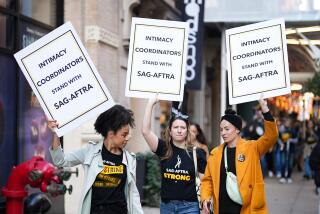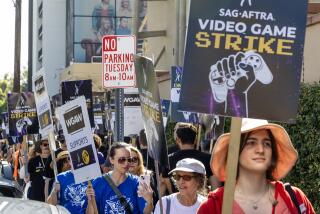SAG board expected to proceed with AFTRA merger
- Share via
When board members of the Screen Actors Guild meet this weekend, they probably will take a historic step toward merging with their smaller sister union, the American Federation of Television and Radio Artists.
The SAG board is expected to endorse a mission statement for the future consolidated union — a statement that was recently approved by leaders of each group — and to create a committee that will develop a plan to make the marriage a reality. AFTRA’s board is expected to take similar action in mid-May. The goal is to have a constitution, dues policy and merger strategy by January, followed by a referendum vote from both unions, said people familiar with the matter who were not authorized to discuss the details.
Such developments underscore a growing consensus on both sides that a merger is crucial to give the unions more bargaining power in their negotiations with media conglomerates at a time when new forms of digital distribution threaten the traditional sources of income for talent. The unions, which ratified a new three-year contract in January, view the merger as a way of ending the turf wars that erupted in 2009, when AFTRA suspended its longtime bargaining partnership with SAG and negotiated a separate prime-time TV contract with the studios.
Although both parties are committed to consummating the merger, pulling it off won’t be smooth or easy. Several thorny issues must be negotiated over the next several months — from what to name the new union to how it should structured.
The process is complicated by the fact that, although the two unions have 45,000 members in common, they have vastly different cultures and histories. SAG, which has its origins in film, has 125,000 members who are all film and TV actors, extras or stunt people. AFTRA, whose roots are in radio, traditionally has catered to actors who work in soap operas, cable television and increasingly prime-time network TV. About one-third of AFTRA’s 70,000 members are not actors but news broadcasters, disc jockeys, singers, dancers and other performers.
“Both organizations have members who are attached to their unions’ history and traditions, and this fact will inevitably present hurdles along the path toward a merger,” said SAG Executive Director David White. “But so far we’ve been able to work through those challenges. I absolutely believe that we have arrived at a great moment for the leadership and the membership of these organizations to figure this out.”
AFTRA President Roberta Reardon, who along with SAG officials has been holding a series of meetings with actors across the country to enlist their ideas, said her union was fully on board.
“I think having one united force of workers facing the future together will give us more leverage and power,” Reardon said.
Hollywood’s actors unions have talked about merging for decades. But attempts in 1998 and 2003 narrowly failed, after critics in SAG argued that it would weaken their union.
This time around, the opposition has been far more muted. SAG’s current president, Ken Howard, was elected in 2009 on a pledge to create a single union. His supporters swept control of the national board, soundly defeating a faction that had backed former SAG President Alan Rosenberg, who was a fierce critic of AFTRA and opposed merging with the smaller union.
Merger opponents like Rosenberg fear that actors would lose their voice within a larger performers’ union. “Actors will have relatively little power in that union,” Rosenberg said.
Support for establishing a single union also has been growing among rank-and-file actors, who have bitterly complained about having to divide their income between two unions as more prime-time TV work is split between the organizations. That has made it harder for members to meet earnings thresholds required for receiving benefits, which range from about $10,000 to $30,000 a year.
“There is growing awareness on the part of members of both unions that now is the time and that it is in the interests of all performers that we get this done as soon as possible,” said Howard, who has joined Reardon on the nationwide “listening tour” with actors.
Currently, the unions jointly negotiate prime-time TV contracts but separately bargain contracts covering work in video games, cable TV and other areas. If a merger occurs, all contracts would be negotiated jointly. Proponents say that would give the unions a stronger hand in bargaining.
“We sit across the table from the same employers, so it really makes no sense for us not to be under the same umbrella,” said AFTRA Executive Director Kim Roberts Hedgpeth.
What the umbrella would look like remains to be seen. AFTRA is a much less centralized union than SAG and gives its local offices across America much more say in negotiating contracts. For example, AFTRA broadcasters negotiate their own agreements with local TV stations.
Both sides would have to agree on how to elect leaders in the new combined union. In AFTRA, national officers are elected by delegates at a national convention held every two years. SAG members elect their leaders directly.
Then there is the matter of whether membership should be open or earned. In order to qualify for membership in SAG, members pay an initiation fee and must have worked at least one day of employment as a principal or in speaking role in a SAG film, TV program or commercial. AFTRA has no such rule.
“It’s going to be a substantial, exhaustive process that is going to require compromise on both sides,” said Ned Vaughn, SAG’s first vice president. “But ultimately, I’m very optimistic we can get this done.”
More to Read
Inside the business of entertainment
The Wide Shot brings you news, analysis and insights on everything from streaming wars to production — and what it all means for the future.
You may occasionally receive promotional content from the Los Angeles Times.











